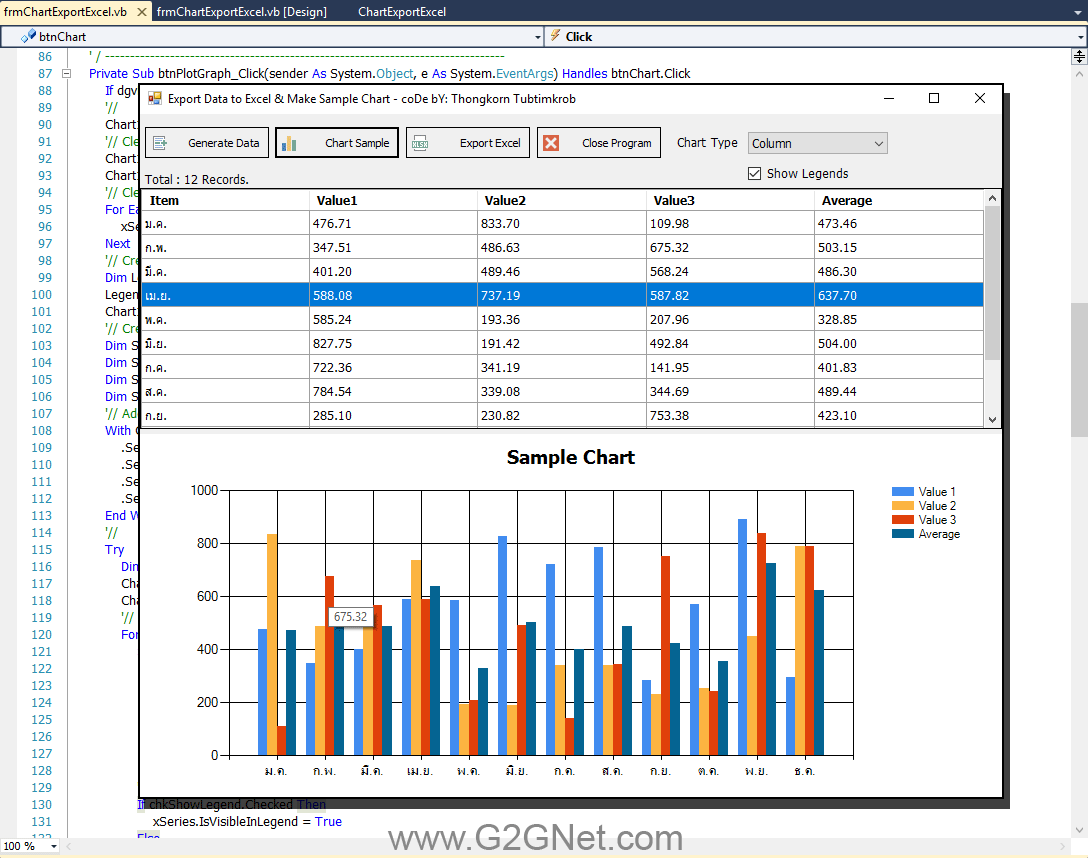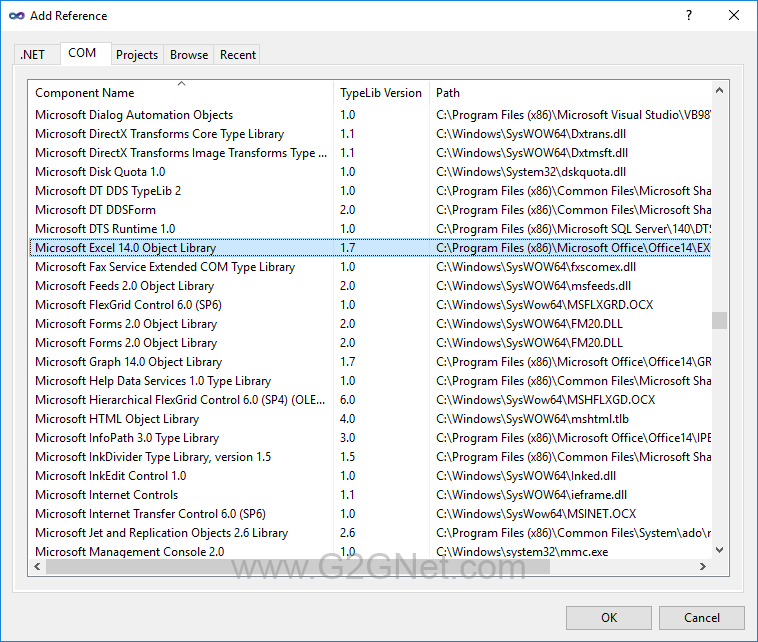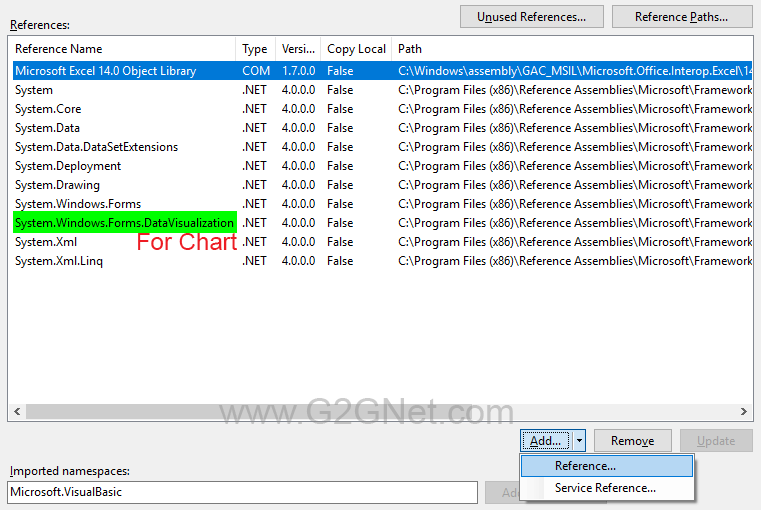|
|

บทความนี้แอดมินขอเหมารวบยอดไปเลยทีเดียวนะครับ กรณีของ การส่งข้อมูลจากตารางกริดไปยัง Excel จะใช้วิธีแบบ Line By Line ซึ่งแน่นอนว่าจะเกิดการทำงานที่ล่าช้ามาก หากกรณีที่มีข้อมูลเยอะๆ ส่วนการทำกราฟ หรือ Chart ก็จะอาศัยข้อมูลที่เกิดจากการสุ่มค่าตัวเลขแบบทศนิยมลงไปในตารางกริด โดยที่แอดมินใช้วิธีการที่ชื่นชอบก็คือ สั่งแบบ @Run Time แต่เพื่อความสะดวก แอดมินจะลาก Chart Control เข้ามาวางบนฟอร์มเอาไว้ก่อน ส่วนป้าย Legend และ Series หรือกราฟที่แสดงผลนั้น จะใช้การเขียนโค้ดเพื่อสร้างมันขึ้นมาแบบอัตโนมัติ นั่นคือเราจะเรียนรู้คุณสมบัติต่างๆของ Chart Control ด้วยโค้ดแทน และด้วยวิธีการนี้มันเกิดความยืดหยุ่นสูงในการปรับแต่งเพื่อไปใช้ในงานอื่นๆต่อไป ...
การส่งข้อมูลออกไป Excel จะทำต้อง References ตัว Microsoft Excel 14.0 Library Object เข้ามาก่อน โดยเลือกจาก COM (Component Object Model) ... (OFFICE 2010) ...


โค้ดในส่วนของการสุ่มข้อมูลเพื่อนำมาใส่ลงในตารางกริด ...
- ' / --------------------------------------------------------------------------
- Private Sub FillData()
- Dim dt As New DataTable
- dt.Columns.Add("Item")
- dt.Columns.Add("Value1")
- dt.Columns.Add("Value2")
- dt.Columns.Add("Value3")
- dt.Columns.Add("Average")
- Dim RandomClass As New Random()
- Dim MyMonth As String() = New String() {("ม.ค."), ("ก.พ."), ("มี.ค."), ("เม.ย."), ("พ.ค."), ("มิ.ย."), ("ก.ค."), ("ส.ค."), ("ก.ย."), ("ต.ค."), ("พ.ย."), ("ธ.ค.")}
- For i As Byte = 0 To 11
- Dim dr As DataRow = dt.NewRow()
- dr(0) = MyMonth(i)
- dr(1) = FormatNumber(RandomClass.Next(100, 1000) + RandomClass.NextDouble(), 2)
- dr(2) = FormatNumber(RandomClass.Next(100, 1000) + RandomClass.NextDouble(), 2)
- dr(3) = FormatNumber(RandomClass.Next(100, 1000) + RandomClass.NextDouble(), 2)
- '// CDbl = Convert to Double
- dr(4) = Format((CDbl(dr(1)) + CDbl(dr(2)) + CDbl(dr(3))) / 3, "#,##0.00")
- dt.Rows.Add(dr)
- Next
- dgvData.DataSource = dt
- Label1.Text = "Total : " & dt.Rows.Count.ToString("#,##") & " Records."
- End Sub
โค้ดในส่วนของการสร้างกราฟ หรือ Chart
- ' / --------------------------------------------------------------------------------
- Private Sub btnChart_Click(sender As System.Object, e As System.EventArgs) Handles btnChart.Click
- If dgvData.RowCount <= 0 Then Return
- '//
- Chart1.Titles.Clear()
- '// Clear Legends & Series
- Chart1.Series.Clear()
- Chart1.Legends.Clear()
- '// Clear Points
- For Each xSeries In Chart1.Series
- xSeries.Points.Clear()
- Next
- '// Create Legends
- Dim Legend1 As Legend = New Legend()
- Legend1.Name = "Legend1"
- Chart1.Legends.Add(Legend1)
- '// Create Series
- Dim Series1 As Series = New Series()
- Dim Series2 As Series = New Series()
- Dim Series3 As Series = New Series()
- Dim Series4 As Series = New Series()
- '// Add Series
- With Chart1
- .Series.Add(Series1)
- .Series.Add(Series2)
- .Series.Add(Series3)
- .Series.Add(Series4)
- End With
- '//
- Try
- Dim myFont As New Font("Tahoma", 14, FontStyle.Bold)
- Chart1.Titles.Add("Sample Chart")
- Chart1.Titles(0).Font = myFont
- '// Define Chart Type.
- For Each xSeries In Chart1.Series
- Select Case cmbChartType.Text
- Case "Column"
- xSeries.ChartType = SeriesChartType.Column
- Case "Line"
- xSeries.ChartType = SeriesChartType.Line
- Case "Point"
- xSeries.ChartType = SeriesChartType.Point
- End Select
- '// Show Legend
- If chkShowLegend.Checked Then
- xSeries.IsVisibleInLegend = True
- Else
- xSeries.IsVisibleInLegend = False
- End If
- '// View the value of a chart point on mouse over.
- xSeries.ToolTip = "#VAL{0.00}"
- Next
- '//
- With Chart1
- .Series(0).LegendText = "Value 1"
- .Series(1).LegendText = "Value 2"
- .Series(2).LegendText = "Value 3"
- .Series(3).LegendText = "Average"
- End With
- '// Show all Axis Label
- Chart1.ChartAreas(0).AxisX.Interval = 1
- '//
- With Chart1.ChartAreas("ChartArea1")
- .AxisX.MajorGrid.LineWidth = 1
- .AxisY.MajorGrid.LineWidth = 1
- End With
- '// LOOP DISPLAY
- For CountData As Integer = 0 To dgvData.Rows.Count - 1
- With Chart1
- '// 0 = Month, 1 = Value1, 2 = Value2, 3 = Value3, 4 = Average
- .Series(0).Points.AddXY(dgvData.Item(0, CountData).Value, dgvData.Item(1, CountData).Value)
- .Series(1).Points.AddXY(dgvData.Item(0, CountData).Value, dgvData.Item(2, CountData).Value)
- .Series(2).Points.AddXY(dgvData.Item(0, CountData).Value, dgvData.Item(3, CountData).Value)
- .Series(3).Points.AddXY(dgvData.Item(0, CountData).Value, dgvData.Item(4, CountData).Value)
- End With
- Next
- Catch ex As Exception
- MessageBox.Show(ex.Message)
- End Try
- End Sub
โค้ดในส่วนของการส่งข้อมูลออกไป Excel
- ' / --------------------------------------------------------------------------------
- '// Export data to Excel.
- Private Sub btnExportExcel_Click(sender As System.Object, e As System.EventArgs) Handles btnExportExcel.Click
- '// ไม่มีข้อมูลในตารางกริด ก็สั่งให้เด้งหนีออกไป
- If dgvData.Rows.Count <= 0 Then Exit Sub
- '// พิจารณาการเลือกใช้ชนิดข้อมูล (Data Type) ให้เหมาะสม
- Dim MaxRow As Integer, MaxCol As Short
- Dim nRow As Integer, nCol As Short
- Dim xlsApp As New Excel.Application
- Dim xlsWorkBook As Excel.Workbook = xlsApp.Workbooks.Add
- Dim xlsWorkSheet As Excel.Worksheet = CType(xlsWorkBook.Worksheets(1), Excel.Worksheet)
- '// S T A R T
- Try
- xlsApp.Visible = True
- '// หาค่าจำนวนแถว
- MaxRow = dgvData.RowCount
- '// หาค่าจำนวนหลัก
- MaxCol = dgvData.Columns.Count - 1
- With xlsWorkSheet
- .Cells.Select()
- .Cells.Delete()
- '// Header
- For nCol = 0 To MaxCol
- .Cells(1, nCol + 1).Value = dgvData.Columns(nCol).HeaderText
- Next nCol
- '// ไล่ตามจำนวนแถว
- For nRow = 0 To MaxRow - 1
- For nCol = 0 To MaxCol
- .Cells(nRow + 2, nCol + 1).value = dgvData.Rows(nRow).Cells(nCol).Value
- Next nCol '// Nested Loop
- '// หากชุดคำสั่งที่อยู่ใน Nested Loop
- '// การให้ตัวแปรต่อท้าย Next จะช่วยให้เรารู้ว่ามันอยู่ใน Loop ไหน
- Next nRow
- '// กำหนดรูปแบบใน WorkSheet
- .Rows("1:1").Font.FontStyle = "Bold"
- .Rows("1:1").Font.Size = 10
- '//
- .Cells.Columns.AutoFit()
- .Cells.Select()
- .Cells.EntireColumn.AutoFit()
- .Cells(1, 1).Select()
- End With
- Catch ex As Exception
- MessageBox.Show(ex.Message, "Error", MessageBoxButtons.OK, MessageBoxIcon.Error)
- End Try
- xlsApp = Nothing
- '// Release memory.
- ReleaseObject(xlsApp)
- ReleaseObject(xlsWorkBook)
- ReleaseObject(xlsWorkSheet)
- End Sub
โค้ดฉบับเต็มทั้งหมด ...
- ' / --------------------------------------------------------------------------
- ' / Developer : Mr.Surapon Yodsanga (Thongkorn Tubtimkrob)
- ' / eMail : thongkorn@hotmail.com
- ' / URL: http://www.g2gnet.com (Khon Kaen - Thailand)
- ' / Facebook: https://www.facebook.com/g2gnet (For Thailand)
- ' / Facebook: https://www.facebook.com/commonindy (Worldwide)
- ' / Purpose: Create data into DataGridView for make the Chart and Export data to Excel @Run Time.
- ' / Microsoft Visual Basic .NET (2010) + MS Excel 14.0
- ' /
- ' / This is open source code under @CopyLeft by Thongkorn Tubtimkrob.
- ' / You can modify and/or distribute without to inform the developer.
- ' / --------------------------------------------------------------------------
- Imports System.Windows.Forms.DataVisualization.Charting
- Imports Excel = Microsoft.Office.Interop.Excel
- Public Class frmChartExportExcel
- Private Sub frmPlotGraph_Load(sender As System.Object, e As System.EventArgs) Handles MyBase.Load
- Label1.Text = ""
- '// Chart Type
- '// https://docs.microsoft.com/en-us/dotnet/api/system.windows.forms.datavisualization.charting.seriescharttype?view=netframework-4.7.2
- cmbChartType.Items.Add("Column")
- cmbChartType.Items.Add("Line")
- cmbChartType.Items.Add("Point")
- cmbChartType.SelectedIndex = 0
- '// Setup DataGridView
- Call InitializeGrid()
- '// Generate Data
- Call btnGenData_Click(sender, e)
- '//
- End Sub
- Private Sub btnGenData_Click(sender As System.Object, e As System.EventArgs) Handles btnGenData.Click
- Call FillData()
- End Sub
- ' / --------------------------------------------------------------------------
- Private Sub FillData()
- Dim dt As New DataTable
- dt.Columns.Add("Item")
- dt.Columns.Add("Value1")
- dt.Columns.Add("Value2")
- dt.Columns.Add("Value3")
- dt.Columns.Add("Average")
- Dim RandomClass As New Random()
- Dim MyMonth As String() = New String() {("ม.ค."), ("ก.พ."), ("มี.ค."), ("เม.ย."), ("พ.ค."), ("มิ.ย."), ("ก.ค."), ("ส.ค."), ("ก.ย."), ("ต.ค."), ("พ.ย."), ("ธ.ค.")}
- For i As Byte = 0 To 11
- Dim dr As DataRow = dt.NewRow()
- dr(0) = MyMonth(i)
- dr(1) = FormatNumber(RandomClass.Next(100, 1000) + RandomClass.NextDouble(), 2)
- dr(2) = FormatNumber(RandomClass.Next(100, 1000) + RandomClass.NextDouble(), 2)
- dr(3) = FormatNumber(RandomClass.Next(100, 1000) + RandomClass.NextDouble(), 2)
- '// CDbl = Convert to Double
- dr(4) = Format((CDbl(dr(1)) + CDbl(dr(2)) + CDbl(dr(3))) / 3, "#,##0.00")
- dt.Rows.Add(dr)
- Next
- dgvData.DataSource = dt
- Label1.Text = "Total : " & dt.Rows.Count.ToString("#,##") & " Records."
- End Sub
- ' / --------------------------------------------------------------------------------
- '// การตั้งค่าเริ่มต้นให้กับตารางกริดในแบบ @Run Time
- Private Sub InitializeGrid()
- With dgvData
- .RowHeadersVisible = False
- .AllowUserToAddRows = False
- .AllowUserToDeleteRows = False
- .AllowUserToResizeRows = False
- .MultiSelect = False
- .SelectionMode = DataGridViewSelectionMode.FullRowSelect
- .ReadOnly = True
- .Font = New Font("Tahoma", 9)
- ' จัดความกว้างของแต่ละหลัก
- .AutoSizeColumnsMode = DataGridViewAutoSizeColumnsMode.Fill
- .AutoResizeColumns()
- ' Adjust Header Styles
- With .ColumnHeadersDefaultCellStyle
- .BackColor = Color.Navy
- .ForeColor = Color.White
- .Font = New Font("Tahoma", 9, FontStyle.Bold)
- End With
- End With
- End Sub
- ' / --------------------------------------------------------------------------------
- Private Sub btnChart_Click(sender As System.Object, e As System.EventArgs) Handles btnChart.Click
- If dgvData.RowCount <= 0 Then Return
- '//
- Chart1.Titles.Clear()
- '// Clear Legends & Series
- Chart1.Series.Clear()
- Chart1.Legends.Clear()
- '// Clear Points
- For Each xSeries In Chart1.Series
- xSeries.Points.Clear()
- Next
- '// Create Legends
- Dim Legend1 As Legend = New Legend()
- Legend1.Name = "Legend1"
- Chart1.Legends.Add(Legend1)
- '// Create Series
- Dim Series1 As Series = New Series()
- Dim Series2 As Series = New Series()
- Dim Series3 As Series = New Series()
- Dim Series4 As Series = New Series()
- '// Add Series
- With Chart1
- .Series.Add(Series1)
- .Series.Add(Series2)
- .Series.Add(Series3)
- .Series.Add(Series4)
- End With
- '//
- Try
- Dim myFont As New Font("Tahoma", 14, FontStyle.Bold)
- Chart1.Titles.Add("Sample Chart")
- Chart1.Titles(0).Font = myFont
- '// Define Chart Type.
- For Each xSeries In Chart1.Series
- Select Case cmbChartType.Text
- Case "Column"
- xSeries.ChartType = SeriesChartType.Column
- Case "Line"
- xSeries.ChartType = SeriesChartType.Line
- Case "Point"
- xSeries.ChartType = SeriesChartType.Point
- End Select
- '// Show Legend
- If chkShowLegend.Checked Then
- xSeries.IsVisibleInLegend = True
- Else
- xSeries.IsVisibleInLegend = False
- End If
- '// View the value of a chart point on mouse over.
- xSeries.ToolTip = "#VAL{0.00}"
- Next
- '//
- With Chart1
- .Series(0).LegendText = "Value 1"
- .Series(1).LegendText = "Value 2"
- .Series(2).LegendText = "Value 3"
- .Series(3).LegendText = "Average"
- End With
- '// Show all Axis Label
- Chart1.ChartAreas(0).AxisX.Interval = 1
- '//
- With Chart1.ChartAreas("ChartArea1")
- .AxisX.MajorGrid.LineWidth = 1
- .AxisY.MajorGrid.LineWidth = 1
- End With
- '// LOOP DISPLAY
- For CountData As Integer = 0 To dgvData.Rows.Count - 1
- With Chart1
- '// 0 = Month, 1 = Value1, 2 = Value2, 3 = Value3, 4 = Average
- .Series(0).Points.AddXY(dgvData.Item(0, CountData).Value, dgvData.Item(1, CountData).Value)
- .Series(1).Points.AddXY(dgvData.Item(0, CountData).Value, dgvData.Item(2, CountData).Value)
- .Series(2).Points.AddXY(dgvData.Item(0, CountData).Value, dgvData.Item(3, CountData).Value)
- .Series(3).Points.AddXY(dgvData.Item(0, CountData).Value, dgvData.Item(4, CountData).Value)
- End With
- Next
- Catch ex As Exception
- MessageBox.Show(ex.Message)
- End Try
- End Sub
- ' / --------------------------------------------------------------------------------
- '// Export data to Excel.
- Private Sub btnExportExcel_Click(sender As System.Object, e As System.EventArgs) Handles btnExportExcel.Click
- '// ไม่มีข้อมูลในตารางกริด ก็สั่งให้เด้งหนีออกไป
- If dgvData.Rows.Count <= 0 Then Exit Sub
- '// พิจารณาการเลือกใช้ชนิดข้อมูล (Data Type) ให้เหมาะสม
- Dim MaxRow As Integer, MaxCol As Short
- Dim nRow As Integer, nCol As Short
- Dim xlsApp As New Excel.Application
- Dim xlsWorkBook As Excel.Workbook = xlsApp.Workbooks.Add
- Dim xlsWorkSheet As Excel.Worksheet = CType(xlsWorkBook.Worksheets(1), Excel.Worksheet)
- '// S T A R T
- Try
- xlsApp.Visible = True
- '// หาค่าจำนวนแถว
- MaxRow = dgvData.RowCount
- '// หาค่าจำนวนหลัก
- MaxCol = dgvData.Columns.Count - 1
- With xlsWorkSheet
- .Cells.Select()
- .Cells.Delete()
- '// Header
- For nCol = 0 To MaxCol
- .Cells(1, nCol + 1).Value = dgvData.Columns(nCol).HeaderText
- Next nCol
- '// ไล่ตามจำนวนแถว
- For nRow = 0 To MaxRow - 1
- For nCol = 0 To MaxCol
- .Cells(nRow + 2, nCol + 1).value = dgvData.Rows(nRow).Cells(nCol).Value
- Next nCol '// Nested Loop
- '// หากชุดคำสั่งที่อยู่ใน Nested Loop
- '// การให้ตัวแปรต่อท้าย Next จะช่วยให้เรารู้ว่ามันอยู่ใน Loop ไหน
- Next nRow
- '// กำหนดรูปแบบใน WorkSheet
- .Rows("1:1").Font.FontStyle = "Bold"
- .Rows("1:1").Font.Size = 10
- '//
- .Cells.Columns.AutoFit()
- .Cells.Select()
- .Cells.EntireColumn.AutoFit()
- .Cells(1, 1).Select()
- End With
- Catch ex As Exception
- MessageBox.Show(ex.Message, "Error", MessageBoxButtons.OK, MessageBoxIcon.Error)
- End Try
- xlsApp = Nothing
- '// Release memory.
- ReleaseObject(xlsApp)
- ReleaseObject(xlsWorkBook)
- ReleaseObject(xlsWorkSheet)
- End Sub
- Private Sub frmPlotGraph_FormClosed(sender As Object, e As System.Windows.Forms.FormClosedEventArgs) Handles Me.FormClosed
- Me.Dispose()
- Application.Exit()
- End Sub
- Private Sub btnClose_Click(sender As System.Object, e As System.EventArgs) Handles btnClose.Click
- Me.Close()
- End Sub
- '// เวลากด Enter ในแถวของตารางกริด จะไม่เกิดการเลื่อนตำแหน่ง
- Private Sub dgvData_KeyDown(sender As Object, e As System.Windows.Forms.KeyEventArgs) Handles dgvData.KeyDown
- If e.KeyCode = Keys.Enter Then e.SuppressKeyPress = True
- End Sub
- ' / ------------------------------------------------------------------
- '// คืนหน่วยความจำกลับคืนสู่ระบบ
- Public Sub ReleaseObject(ByVal obj As Object)
- Try
- System.Runtime.InteropServices.Marshal.ReleaseComObject(obj)
- obj = Nothing
- Catch ex As Exception
- obj = Nothing
- Finally
- '// GC = Garbage Collection
- GC.Collect()
- End Try
- End Sub
- End Class
ดาวน์โหลดโค้ดต้นฉบับแบบเต็ม VB.NET (2010) ได้ที่นี่ ...
|
ขออภัย! โพสต์นี้มีไฟล์แนบหรือรูปภาพที่ไม่ได้รับอนุญาตให้คุณเข้าถึง
คุณจำเป็นต้อง ลงชื่อเข้าใช้ เพื่อดาวน์โหลดหรือดูไฟล์แนบนี้ คุณยังไม่มีบัญชีใช่ไหม? ลงทะเบียน
x
|
